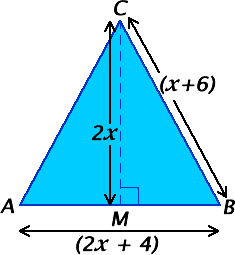Resolução do exercício de matemática:
1.
Como o triângulo é isósceles e [CM] é a altura relativa à base [AB], então:

Pelo teorema de Pitágoras temos que:

Logo,

Portanto o valor de x é 4.
2.
 metros.
metros.
3.



A área do triângulo [ABC] é de  .
.
Na figura, [ABC] é um triângulo isósceles e [CM] a altura relativa à base [AB]. De acordo com os dados da figura determine:
1. O valor de  .
.
2.  .
.
3. A área do triângulo [ABC].
(As medidas são em metros.)

Resolução do exercício de matemática:
1.
Como o triângulo é isósceles e [CM] é a altura relativa à base [AB], então:

Pelo teorema de Pitágoras temos que:

Logo,

Portanto o valor de x é 4.
2.
 metros.
metros.
3.



A área do triângulo [ABC] é de  .
.